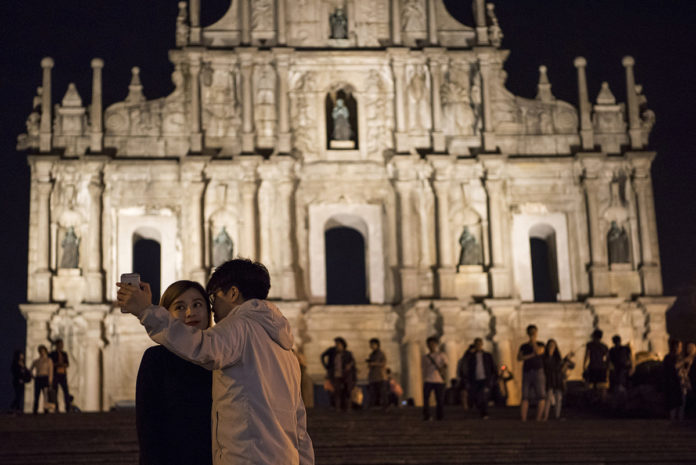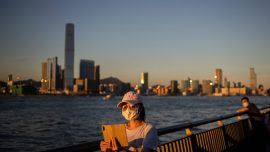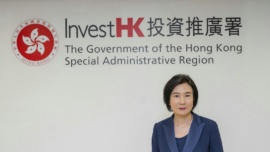There is an urgent need for people in the field of heritage protection outside the government, says the head of the Cultural Heritage Department of the Macau Cultural Affairs Bureau, Deland Leong Wai Man. Pointing out the challenges of heritage conservation she has encountered since taking on the position, and following the call for action from the World Heritage Committee in July, she shares her vision and work in relation to ways – both available and being procured – to expand the scope of conservation by engaging citizens and professionals alike
What are the main challenges you have faced since you became the head of the Cultural Heritage Department?
I became the head of the Cultural Heritage department more or less one year after the new Cultural Heritage Protection law became effective. After the law was enacted in March 2014, it has actually been quite a lot of work. Our department work has evolved in different areas. We have to provide a lot of compulsory opinions to different departments, like the CPU [Urban Planning Committee], all the building projects, or the commercial signage, especially when they are heritage buildings, but not only. For other, normal, buildings within the buffer zone, they ask our opinion as well, sometimes, even [those] out of the buffer zone, and then we need to do the analysis work and provide our opinion. I think we can see the changes from the several hundreds up to now more than one thousand requests for opinions a year. So we need a lot of colleagues doing this work, because we need to go to the site to see the actual situation and do the analysing work and then provide the opinion related to the protection of our heritage. This is one of the big changes.
What other challenges have ensued from the increased need to provide opinions?
Considering everything, there are more than 600 heritage buildings and sites. Most of them belong to private owners. The law states very clearly that those owners have to comply with building maintenance, and, from the IC point of view, we have to monitor them, to understand every single condition, so we need to establish a very good method to do building inspections. This is one of the very big challenges for us, because we are trying to do it regularly, and inspect all the buildings at least twice a year. If we do it at that pace, we need to do it more than one thousand times every year. But it is not enough, because for some buildings, we cannot only go there today and not go there tomorrow. That’s very challenging, because before we did not really have a very systematic way to do the inspection work, but now we have been building up a system to make it more systematic and regular. We also need to set up a notification system to inform the owners, take pictures, record the conditions of the buildings, and remind them that maybe it is time for them to do repair work. It is a good thing, because to inform them [the owners] is to help our promotion work as well. So we also need to set up a follow up method, to keep every record, and a tracking system.
How do you go about the inspection and monitoring work, and what is your current priority?
For some very important heritage buildings, especially those listed as World Heritage, we need to keep monitoring the conditions, using technical devices to monitor if there are any changes. But for the ‘normal’ heritage buildings, our colleagues would go out most of the time. One of the priority works is the Protection Management Plan [PMP] for the Historic Centre of Macau. At the moment, we are trying to organize a public consultation, hopefully, within this year. At the same time, we will start drafting the administrative regulations, because the management plan will be announced as a regulation, as it is foreseen in the Cultural Heritage Protection law. It means that it has law value, so it will have more power. We also plan to submit it to the World Heritage Committee [WHC] by December next year, in addition to the report [on the state of heritage conservation]. The report’s aim is to inform the WHC about the current situation for every different field they are concerned about, for example, the situation we are already in for the master plan, the urban planning, etc. We can combine them, or separate them and submit the draft of the management plan first.
How is the current work evolving and why the delay in the past?
We have been working on it. Our Cultural Heritage Protection law was effective in 2014 and at the end of that year we already had the first framework consultation. The WHC expected we submit it to them in 2015, but practically it is a bit delayed. So, in 2014, we had the report and, of course, it is a framework. The aim for that framework is to make it less ‘heavy’ for all the people to understand what the management plan is. Some people may not know the difference between Macau heritage and World Heritage, or what the Historic Centre is. So I think it was really a chance to promote and to let people understand what the Historic Centre of Macau is, and what its value is. After the framework, what we are doing now is the full version of what the management plan is about.
The IC President said that you are going ahead with the PMP, even if the Master Plan for Macau is not ready. Can you propose a management plan without having a Master Plan for the city in hand?
The law doesn’t really say that they have to come out at the same time. Actually, because we have already started the work, and because we have to fulfil UNESCO’s request, I think that by the time we have the management plan, and also because in the urban planning law it is said that the master plan has to use our management plan as a reference, even for the new reclamation land, we might submit it first.
In regards to the time frame and the delays, how much of it is linked to a lack of personnel to conduct the work?
Well, it’s never been enough people. I think it is not only for the management plan, but also for the heritage protection work, as I already said, for giving opinions, providing inspection work, and so on, because at the moment we only have some 40 people in our department. Every year, we not only provide more than a thousand opinions, IC has sent out more than a 100 notification letters to the owners of the corresponding buildings since 2016. We also have more than 40 sites to do conservation work on every year, and it is not only for the conservation itself. We think it is very important for protecting heritage to make fully adoptive re-use for some of the buildings. Our department is in charge of some important re-use projects. Last year we had four re-use projects finished, the Chong Sai Pharmacy, the Treasure of Sacred Art of Saint-Joseph’s Seminary, the maritime workshop, and the library in Patane. I actually worked on the design of that building when I was not in this position. As an architect, I enjoy very much working on re-use projects.
Is the department currently considering partnerships with the private sector to help develop adoptive re-use projects such as the one that was done in the past at the Tak Seng pawnshop?
I think that in the long-term it should be like this, because the government, for the human, or even the financial resources, maybe it will be changing. I think it is the right direction, to get the private sector more involved in doing the protection work. After Tak Seng, there was the Watchmen house. Of course, it is not as big, or important, or beautiful as Tak Seng, but it is a meaningful building, because it was abandoned for a long time.
We are planning to apply it for the Asia-Pacific Awards for Cultural Heritage Conservation, which has to be a project under public-private partnership. But the conservation work was only finished in 2015, and under the Awards’ regulation, the building has to have been finished for three years, because they want to see the effect or the benefits to the community. The group that is running it are even promoting some activities, tour guides for the community, for people to understand the history of the Inner Harbour area and their own history. So I think it quite fulfils what the award is, as long as we are counting the three years to submit the application.
One project that has sparked controversy is the hotel planned to be built at Fisherman’s Wharf, due to disagreements concerning its height limit. Any decisions on that yet?
We provided an opinion in which we said that it would be nice if it were kept at 60 metres above sea level. The 83/2008 executive order, that is, the order to control the height for the protection of the Guia Lighthouse, also says that [the height limit for the] area is no more than 90 metres. If I remember it correctly, the urban planning department provided a draft twice. In the first one, it was proposed 60 metres, and since there was a lot of discussion in the urban planning committee, they said they would re-consider it. So in the next draft, it was 90 metres. When they proposed it, there was a different opinion and a lot of discussion as well. Because there is not only one side, there are many sides and opinions about the height. At the moment, I think there is no final decision yet.
Shouldn’t the opinion of the Cultural Heritage Department be binding in this case?
The executive order is also based on defining a better way to protect World Heritage by considering the relationship between the Guia Lighthouse and the sea view, so I think that in this order the visual corridor is already considered. If you say the building is 90 metres, it is still under the order, but of course our opinion says that lower would be better. So, I think we have to be close to what we already provided, and see how the OP [Land, Public Works, and Transport Bureau] is going to react first. We will continually provide our opinion if they need it. They are still analysing it, but they already understand our opinion.
IC was under pressure a few months ago when the Commission Against Corruption (CCAC) released a report detailing hiring procedures at the cultural bureau without proper tendering. How do you cope with the personnel shortage situation?
I think that we need to have more people related to the heritage protection field in the market, not necessarily in the government departments. We need their position to help in other ways, that’s what I think. Even for the re-use projects, for the design, in the future, if there are any cases like the library one [in Patane], we welcome architects from the outside to do the projects, rather than in-house. Even for the building inspection work, because there are so many, so our colleagues would go for those important parts and for those other buildings, we would tender out to professional institutions, companies, or engineering consultants. They have the tools, the professional people, to help. We are already doing some, because we have so many heritage-classified buildings. We also have a co-operation [agreement] with the OP to do inspection work as well. That’s a long-term and sustainable way for us. I mean, I cannot answer for the whole IC. But in our department, we are going in this direction.
What about the budget for all the activities you conduct at the department today? Has it decreased from last year?
It is rather stable. In 2016, we implemented more than 40 projects, including revitalisation, renovation, maintenance, etc. The total cost was about MOP25 million. We also inspected local heritage buildings more than 700 times in 2016. The budget is related to how many people, and how much work you can do. For example, some churches take more than half a year for conservation work. But before doing that, we have lots of document work to do as well. So, time, money, and people, are all related.
Would you say that pressure from private development is one of the biggest challenges facing heritage preservation in Macau?
I think it is challenging for every city with heritage. Before, we didn’t have so many developments, but now with many developments, I can only say that we are going to be busier because we have to respond very quickly to analyse situations and to provide opinions. But as long as we have a law, every government department and even the private sector, they have to obey the law, which is a very good tool for protecting heritage here. Another work which I think is very important is the promotion work, because now some people, some property owners, they actually see there is no conflict between development and heritage protection. They are even the active ones to come up to you for co-operation, because they want to get better results, rather than arguing and fighting with you. So, hopefully, I think we will have a lot of promotion work, maybe starting from this summer.
Are there any plans to improve the overall situation of San Ma Lou [Senado Square]? Parts of it have been abandoned for some time now, and a new building appeared when the old teahouse collapsed.
That’s why the inspection work is so important. We sent out so many letters last year until now. San Ma Lou is very peculiar. Closer to Senado Square, it is very expensive, people make full use of the buildings. But if you go further, it seems that it is empty. So, we sent many letters, and we got responses from some of the owners, who approached us to ask how to do the repairing as we requested. It takes a bit of time, but with our inspection and notification works, it will be getting better. Before, we didn’t have that system to inform them. We spend a lot of effort in doing this because when we send the notification, they sometimes approach us, and we have to meet them, and tell them how to do the work. If they don’t understand, we have to keep telling them how to do it. So, it will be difficult in the beginning, but hopefully it will become smoother with time.
























